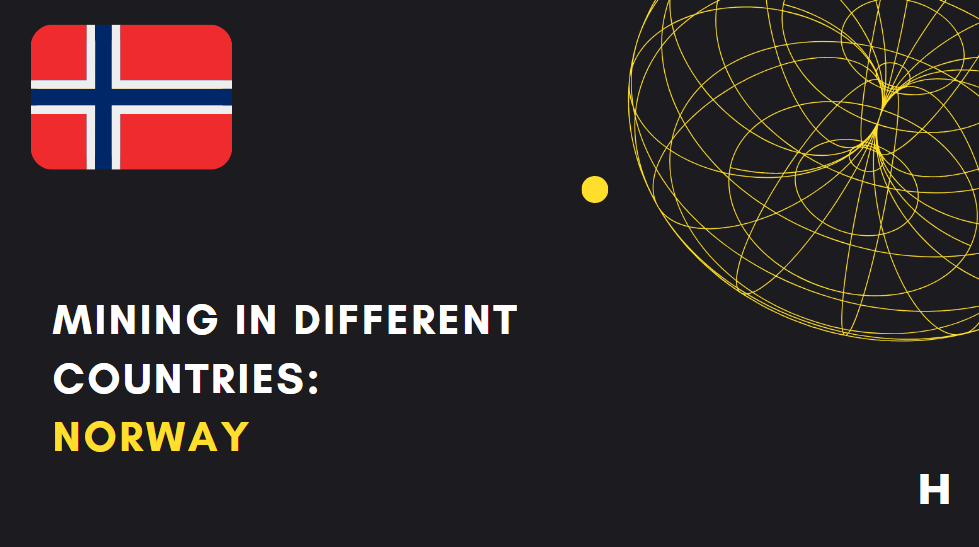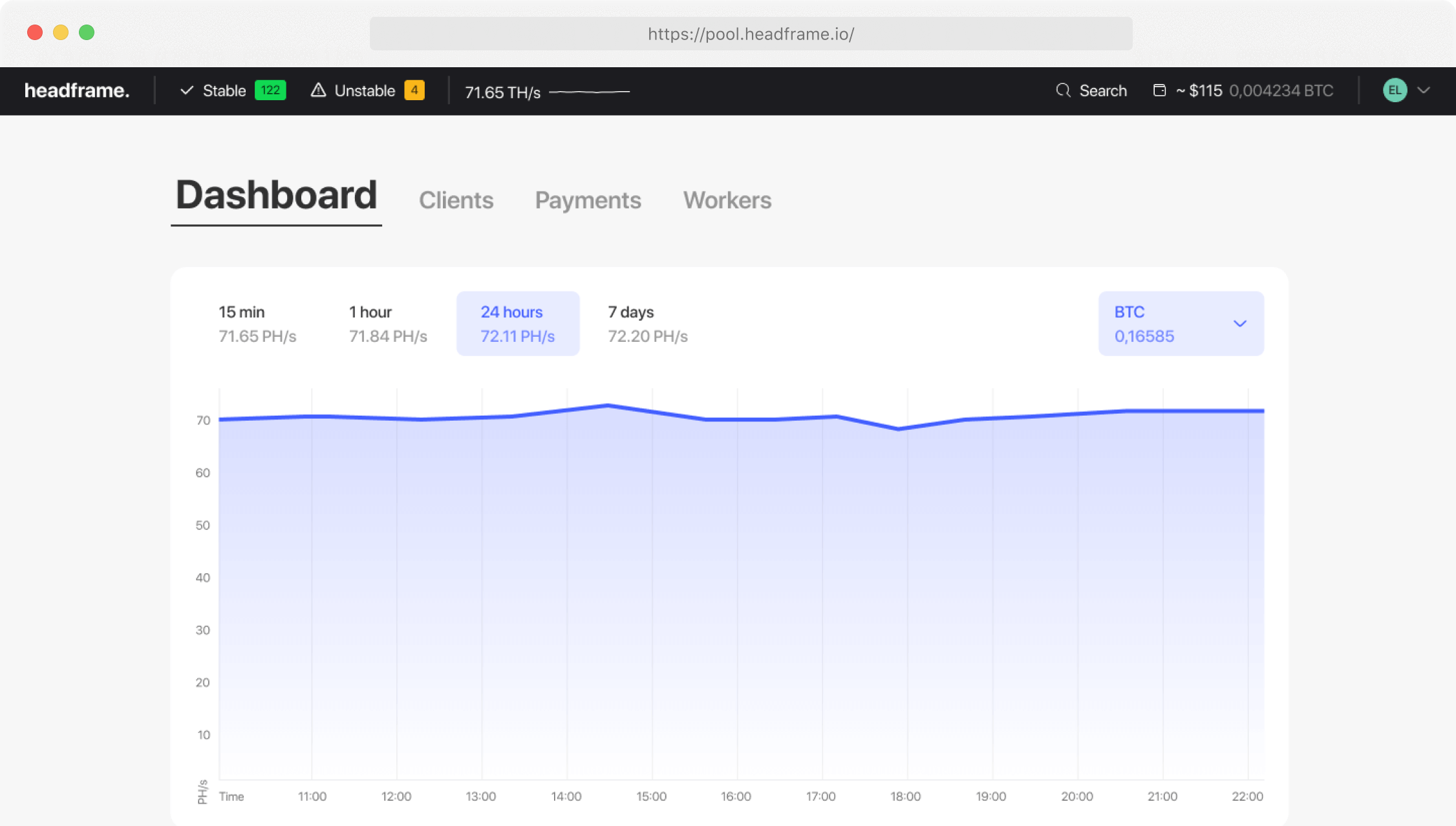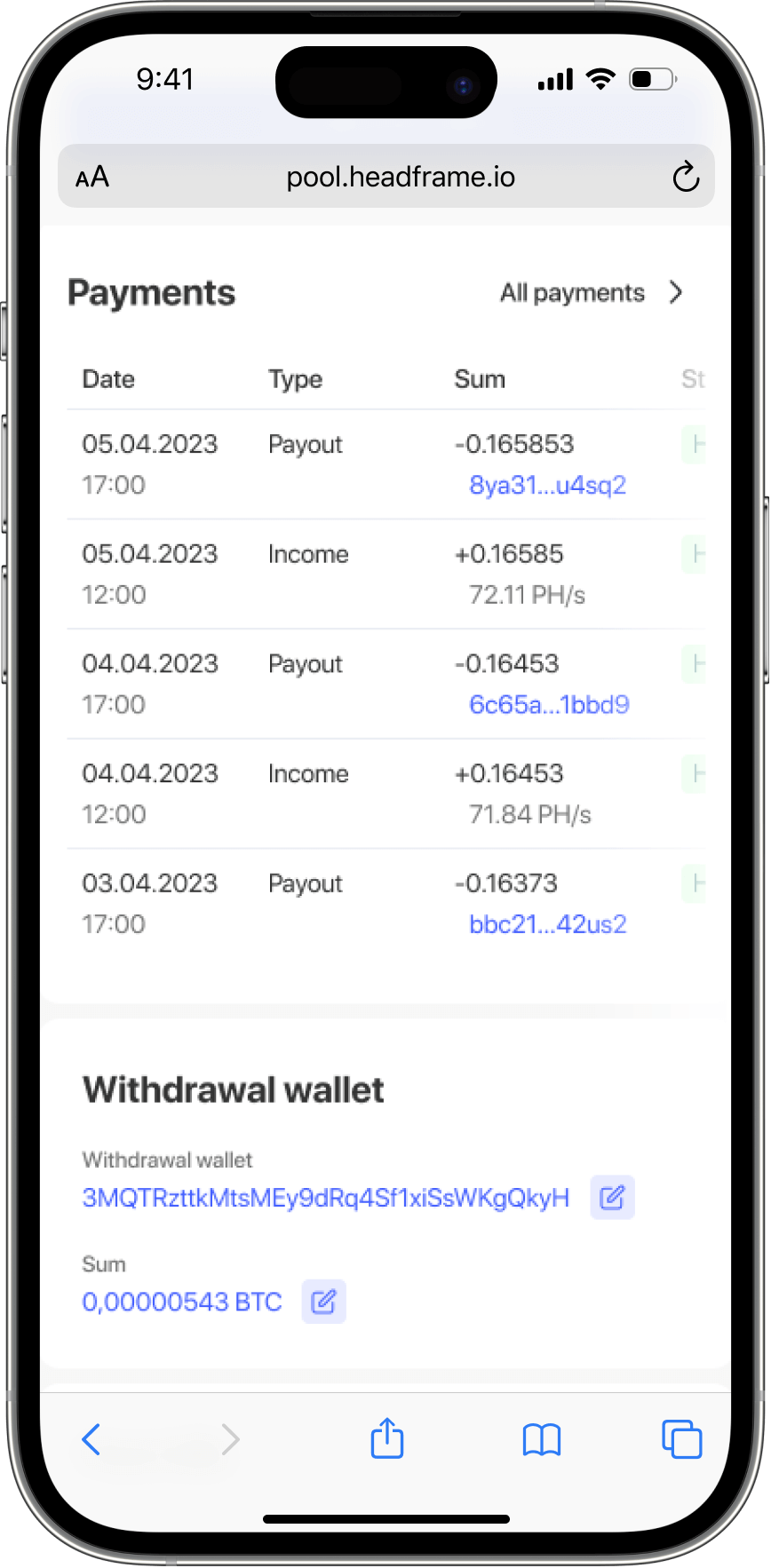
Mining in Norway
Thanks to the presence of hydroelectric power plants, Norway has become Europe’s largest bitcoin mining center. But what else is driving the bitcoin mining industry in this Arctic outpost?
Earn more money with Headframe
Join a mining pool and get the best profitability in mining. Already more than 10,000 miners trust Headframe.
This article explains why Norway has attracted Europe’s largest bitcoin mining industry.
- Arctic outpost of bitcoin miners
- Who is mining bitcoin in Norway?
- Europe’s largest hydroelectric power producer
- Will electricity remain cheap in northern Norway?
- Cold weather provides excellent operating conditions
- Politically stable country, but bitcoin mining remains controversial
- Conclusion
Arctic outpost of bitcoin miners
Let’s define the size of the Norwegian bitcoin mining industry.
The University of Cambridge periodically publishes its bitcoin mining map, estimating the share of hashrate attributable to different countries. According to the latest version for January 2022, Norwegian miners generate 0.74% of Bitcoin hashrate. Multiplying this percentage by Bitcoin’s electricity consumption at that time, we get a Norwegian electricity consumption for Bitcoin mining of 69 MW.
The Cambridge estimate was made over a year ago and was based on a top-down methodology using data from only four mining pools. We now present an updated estimate based on identifying as many Norwegian bitcoin mining operations as possible and obtaining approximate power consumption data from industry insiders.
The Norwegian bitcoin mining industry is estimated to consume about 250 MW. This energy consumption should correspond to a Norwegian share of the global hashrate mining industry of 2.9%, based on the Hashrate Index of bitcoin mining energy consumption, which currently stands at 8.5 GW. This estimate is significantly higher than Cambridge’s and illustrates the growth of the Norwegian bitcoin mining industry in 2022.
Who mines bitcoin in Norway?
Mining just under 3% of the bitcoin hashrate, Norwegian miners make a small but still important contribution to the security of the bitcoin network. Who are they and where do they work?
The most well-known multinational companies are Bitfury, COWA, Bitzero and Bitdeer, while the local ones are Cryptovault and Arcane Green Data.
Due to the huge difference in electricity prices between regions, all bitcoin miners in Norway work in the middle and northern parts of the country, where free hydroelectricity is abundant. Before the energy crisis hit Europe in late 2021, many bitcoin miners worked in the south of Norway, but eventually moved to the north due to the spike in electricity prices.
Europe’s largest hydroelectric power producer
The main reason Norway is attracting a significant bitcoin mining industry is its abundance of renewable energy. Norway is an energy powerhouse and will produce the second highest amount of electricity per capita in the world in 2021.
Norway’s mountainous terrain and humid climate provide excellent opportunities for hydropower development. In the 20th century, Norwegians capitalized on these opportunities by building hundreds of hydroelectric power plants throughout the country. As a result, Norway is among the few countries in the world where hydroelectricity is produced almost entirely by hydroelectricity.
In 2021, 92% of the country’s electricity was generated by hydropower and 7% by wind. Most of Norway’s hydropower capacity was built during the post-war industrialization period, and build-up has slowed since the 1990s. Since then, wind power has accounted for most of the capacity additions.
Norway’s 100 percent renewable energy makes it attractive to bitcoin miners who want to claim carbon neutrality. Another advantage is the low electricity prices.
Norway’s geography is dominated by fjords and mountains. In such geographical conditions, building power lines is very difficult and expensive. As a result, there are significant transmission constraints within the country, especially between the middle and southern parts of the country.
Due to these transmission constraints, Norway has divided its market into five price zones: ‘northern Norway’, ‘middle Norway’, and the three southernmost price zones, ‘southern Norway’.
Historically, electricity prices in all regions of Norway have been similar, with the average annual price of electricity in all price zones from 2013 to 2020 ranging from $10 to $50 per MWh. Electricity prices in Norway have historically been low, albeit with some annual volatility due to differences in rainfall.
At the end of 2021, electricity consumers in southern Norway suddenly saw their electricity bills skyrocket to unimaginable heights. Southern Norway is relatively well connected to European energy markets through several undersea cables. Therefore, the sharp rise in electricity prices on the continent quickly spread to southern Norway.
In 2022, the average electricity price in southern Norway reached $209 per MWh, making bitcoin mining prohibitively expensive. At the same time, prices in middle and northern Norway remained low at $44 and $26 per MWh. All miners operating in southern Norway have already shut down their operations or moved north.
Transmission restrictions between middle and southern Norway prevent the flow of cheap electricity to the south and protect consumers in these regions from electricity price inflation in Europe.
Will electricity remain cheap in northern Norway?
Even in the midst of the European energy crisis, northern Norway still has some of the cheapest electricity in the world. But will these good times last?
Norwegian grid operator Statnett estimates that electricity prices in the middle and northern parts of Norway will rise to $65 and $58 per MWh in 2023. These price increases reflect an expected normalization of weather conditions, as 2022 saw unusually high rainfall, which led to abnormally low electricity prices.
Statnett forecasts that electricity prices in the Midwest and the North will decline between 2023 and 2026, reaching $44 and $27 per MWh in 2026. In 2027, Statnett estimates that prices will increase significantly (but remain relatively low) due to the opening of new transmission capacity.
Statnett estimates that middle and northern Norway will remain a favorable location for bitcoin miners in terms of electricity prices.
Three factors can influence electricity price developments in middle and northern Norway: the development of local generation capacity, changes in local electricity demand and the expansion of transmission capacity between middle and southern Norway. Let us consider these three factors sequentially.
There are few plans to increase generation capacity in middle and northern Norway. At the same time, electricity consumption is likely to increase significantly by 2030. Northern Norway is a relatively attractive location for certain government-approved electricity-intensive industries due to low electricity prices. In addition, electricity demand in northern Sweden is growing rapidly, which could affect electricity prices in Northern Norway, as the two markets are relatively well connected. Nevertheless, it will likely take several years for industrial demand for electricity to grow to a meaningful level.
What about the development of transmission capacity? Here it should be understood that electricity in Scandinavia is usually transmitted from north to south via Norwegian and Swedish transmission lines. Since the electricity markets in the northern parts of these countries are well interconnected, removing transmission constraints between north and south Sweden would likely lead to higher electricity prices in northern Norway as well. Norway and Sweden plan to increase the capacity of north-south transmission lines, but this process will take many years, and significant restrictions on north-south transmission will remain until at least 2030.
What will happen to electricity prices in northern Norway is still unclear. TSO predicts that prices will remain low until at least 2027. However, in the long term, prices in northern and southern Norway are likely to converge due to improved capacity and increased electricity demand in the north. Therefore, miners will enjoy low electricity prices in northern Norway for another five years before they rise. In favor of this prediction is the fact that power purchase contracts suddenly become more expensive with a time horizon of more than five years.
Cold weather provides excellent operating conditions
There are few countries where operating mining equipment is easier than in Norway. The cold climate of this Arctic country provides natural cooling for heat-producing mining operations. Average monthly temperatures in northern Norway range from -4C (+26F) to +13C (+56F) during the coldest and warmest months. The air is also characterized by its cleanliness. For bitcoin mining, the climate could hardly be better.
The favorable climate means that maintaining and operating a mining operation is easier than in hotter bitcoin mining centers like West Texas. Miners can easily run air-cooled machines and don’t have to worry about building additional cooling infrastructure. In addition, the machines can last longer.
The low failure rate due to the cold climate also means less need for maintenance, which can lead to lower operating costs.
Some small companies in this region sometimes leave their farms running for weeks at a time with no employees present except for periodic safety checks.
Politically stable country, but bitcoin mining is still controversial
Norway has historically been a stable and business-friendly country with acceptable regulatory conditions for most businesses. Corruption is virtually non-existent and transparent processes ensure that everyone is treated equally under the law. An example is the energy law, which prevents the transmission system operator from discriminating against different industries in the allocation of electricity supply. Thanks to a stable and transparent business environment, Norway was ranked ninth in the World Bank’s 2019 Ease of Doing Business Index.
Let’s talk about taxes – a boring but important topic. The corporate tax level for most industries in Norway is 22%, which is relatively low compared to most European countries. Meanwhile, VAT is 25% and applies to imported products, including equipment. However, miners can avoid import VAT by registering their companies in the Norwegian VAT registry.
Until 2023, Norwegian miners were entitled to a reduced electricity tax as part of the broader data center industry. They will now have to pay NOK 0.0916 (USD 0.0093) per kWh from January to March and NOK 0.1584 (USD 0.016) per kWh from April to December, corresponding to an average annual electricity tax of NOK 0.1417 (USD 0.014) per kWh. In comparison, miners previously paid only NOK 0.00546 ($0.00055) per kWh. This drastic increase in electricity tax will result in a significant increase in overall electricity prices for Norwegian miners.
Why did the government suddenly raise the electricity tax for miners and other data centers? The short answer is that they want to smoke them out. Many Norwegian politicians, both nationally and locally, have a complicated relationship with bitcoin mining. Some politicians, mostly from the left wing, have persistently expressed a desire to ban the activity, but have never succeeded. After one such failed attempt at a ban, they seem to have realized that raising the electricity tax is the only way to curb the industry.
This is not the first attempt by the Norwegian government to make life harder for miners by raising the electricity tax. In 2019, the government tried to raise the electricity tax specifically for miners, but abruptly abandoned the idea a year later. Perhaps they realized that such selectivity in deciding who is eligible for the electricity tax cut likely contradicts a number of Norwegian and international laws.
The difference this time is that the electricity tax increase affects the entire data center industry, not just the miners. Yes, you got that right. The Norwegian government is willing to throw the entire data center industry under the bus to curb bitcoin mining. This is surprising because in 2016, the Norwegian government presented a national data center strategy to create a data center in Norway.
Norway may have history on its side, but like most Western countries, it is moving towards a governance structure characterized by increased centralized planning. In such an environment, government support is invaluable. Unfortunately, the Norwegian government does not support bitcoin mining and would instead like to reserve electricity capacity for other electricity-intensive industries such as battery manufacturing, which is more in line with Norway’s and the EU’s energy transition ambitions.
Nevertheless, bitcoin mining in Norway is by no means necessarily impractical. As mentioned, Norway is still a law country, and politicians face many legal and procedural hurdles when trying to dismantle the industry. Compare this to some Latin American countries where bitcoin mining is booming, where governments are seemingly more favorable to bitcoins, but where one politician can shut down your mining operation on a whim.
Conclusion
Thanks to cheap renewable energy, a cold climate and historical political stability, Norway has attracted a significant mining sector generating nearly 3% of bitcoin’s hashrate.
Scarcity-hit hydropower has spared northern Norway from the energy price inflation gripping Europe at the end of 2021, making it Europe’s largest bitcoin mining center. It’s important to note that electricity is only cheap in northern Norway, but not in the southern part of the country.
Norway has historically been a politically stable country with acceptable regulatory conditions for most businesses. However, bitcoin mining remains controversial. Norwegian regulators are keen to scale back the industry to make room for other electricity-intensive industries in line with Norway’s and the EU’s ambitions. Therefore, they recently significantly increased electricity taxes for all data centers, including miners.
Competition for electricity with these government-approved industries gives the Norwegian bitcoin mining industry little room for growth. In addition to growing political opposition, there is also some risk of changes in electricity prices. The country will not have any new sources of electricity in the next few years, while the demand for electricity could increase significantly. In addition, the government plans to increase the power transmission capacity between the northern and southern parts of the country.
Nevertheless, bitcoin miners are likely to have at least five more good years of work in a stable country with low electricity prices and excellent working conditions.
Source: https://hashrateindex.com/blog/bitcoin-mining-around-the-world-norway/


